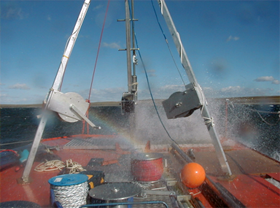Coupling between southern hemispheric Westerlies and atmospheric CO2 at the end of the last Glacial
A Patagonian lake sediment archive documents a strong intensification of the southern Westerlies contemporaneous to the increase of atmospheric CO2 to Holocene levels during Late-Glacial times. This observation strongly supports the hypothesis that the increase of this atmospheric greenhouse gas was linked to large-scale shifts of wind belts in the southern hemisphere.
05.08.2013
Platform for sediment coring on the Patagonian lake Laguna Potrok Aike during strong Westerlies, Photo by B. Zolitschka
 The causes for the rise of the greenhouse gas CO2 in the atmosphere at the end of the last Glacial are a matter of controversial scientific debate. One explanation is the release of CO2 from deep ocean reservoirs. In a recent publication in the journal “Geology” researchers led by Christoph Mayr (Universities of Erlangen and Munich) and Andreas Lücke (Forschungszentrum Jülich) tested the hypothesis of a stimulation of increased carbon dioxide release from the deeper ocean by intensification of the southern hemispheric Westerlies about 12,800 years ago. Within a project funded by German Research Foundation (DFG) and the German Federal Ministry of Education and Research (BMBF) the authors investigated sediments from the 100 m deep Patagonian lake Laguna Potrok Aike located in the present core region of the southern Westerlies.
The causes for the rise of the greenhouse gas CO2 in the atmosphere at the end of the last Glacial are a matter of controversial scientific debate. One explanation is the release of CO2 from deep ocean reservoirs. In a recent publication in the journal “Geology” researchers led by Christoph Mayr (Universities of Erlangen and Munich) and Andreas Lücke (Forschungszentrum Jülich) tested the hypothesis of a stimulation of increased carbon dioxide release from the deeper ocean by intensification of the southern hemispheric Westerlies about 12,800 years ago. Within a project funded by German Research Foundation (DFG) and the German Federal Ministry of Education and Research (BMBF) the authors investigated sediments from the 100 m deep Patagonian lake Laguna Potrok Aike located in the present core region of the southern Westerlies.
Platform for sediment coring on the Patagonian lake Laguna Potrok Aike during strong Westerlies, Photo by C. Mayr

Sediment parameters demonstrate that drought conditions like today occurred during the Late Glacial at the same time when the greenhouse gas CO2 began to reach a level characteristic for the present warm period, the Holocene, during pre-industrial times. This observation is interpreted as a southward shift and intensification of the Westerlies at the end of the last Glacial that evoked the end of the Glacial by stimulating CO2 release from the deep Southern Ocean. The study demonstrates that position and strength of the southern Westerlies are critical parameters for the global carbon cycle and thus for our climate.

